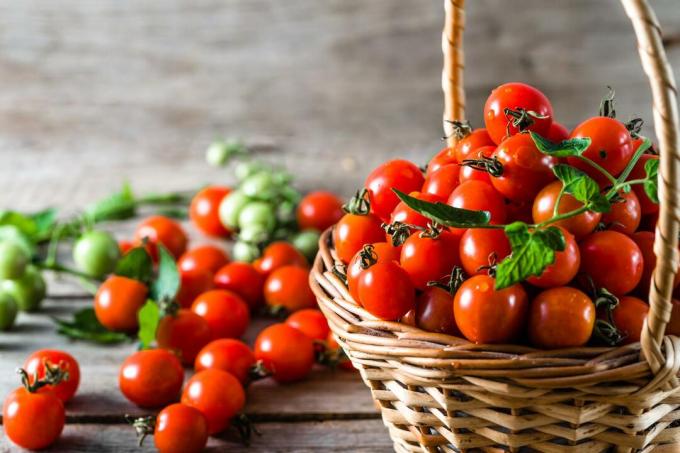The Mexican honey tomato is also called sugar grape because of its sweet taste. We will introduce you to the Mexican honey tomato and tell you everything you need to know about planting and caring for this tomato variety.

contents
- Mexican honey tomato: profile
- origin and history
- Properties and taste of the Mexican honey tomato
- Planting Mexican honey tomatoes: tips for outdoor and pot
-
Mexican honey tomato: care
- Support Mexican honey tomato
- Fertilize Mexican honey tomato
- Harvesting and using Mexican honey tomatoes
Mexican honey tomato: profile
| synonyms | 'miel du mexique', 'sugar grape' |
| fruit | cocktail tomato; Red |
| the taste | aromatic, very sweet |
| maturing time | early |
| growth | Stick tomato, up to 250 cm |
| location | Greenhouse, protected outdoor area, pot (sunny house wall) |
origin and history
As the name suggests, the 'Mexican honey tomato' comes from Mexico. It is also known by the name 'Miel du Mexique' or 'sugar grape'. How old this variety is and how long it has been growing in our gardens and on balconies is unfortunately not known.
Properties and taste of the Mexican honey tomato
The 'Mexican honey tomato' is a typical cocktail tomato with many small, red and round fruits. The fruits are about the size of a two-euro coin and masses of these small delicacies hang on a plant. The plants reach a height of up to 250 centimeters and the ripening period begins very early in July. The fruits have a thin skin and a lot of seeds inside. The 'Mexican honey tomato' is a seed resistant variety, so it can be sown again next year. The taste is aromatic and very sweet, with hardly any acid - a real sweet tomato.

Planting Mexican honey tomatoes: tips for outdoor and pot
The thin skin of the red fruit bursts easily when too much water is added. Therefore, outdoors, it should only be under a rain canopy. In the greenhouse, but also in the bed under rain protection, she feels very comfortable and also in the pot On a sunny house wall, the 'Mexican honey tomato' bears large quantities of its sweet, round ones Fruit. Fill the pot with a soil that is made specifically for tomatoes, like ours Plantura tomato and vegetable soil. The advantage lies in the special composition of nutrients, which enables healthy growth and a rich harvest for the young plants. The right thing Watering and mulching the tomato plants is essential for health and a high fruit load.
Mexican honey tomato: care
The 'Mexican honey tomato' is generally quite easy to care for, but it also welcomes a few care measures after planting.
Support Mexican honey tomato
The 'Mexican honey tomato' can be grown with three or four shoots instead of just one. The advantage is that there is hardly any need to trim and the plant does not grow as tall. Instead, it spreads, which is why it needs several sticks for support. But it also bears a lot of fruit on the additional shoots.
Fertilize Mexican honey tomato
So that you can harvest many red fruits of the 'Mexican honey tomato' throughout the season, you should use the Provide a good supply of nutrients to the tomato plant. The easiest way is to apply a mostly organic slow-release fertilizer like ours to the surface Plantura organic tomato fertilizer. With just two doses two months apart, you provide your plants with all the minerals and nutrients they need to harvest plenty of fruit and avoid deficiency symptoms. With tomato plants in pots, the limited root space can lead to deficiency symptoms more quickly. From June, during the main growth period, you should therefore fertilize weekly with a universal liquid fertilizer. Our purely organic liquid organic tomato & vegetable fertilizer combines effectiveness with sustainability. Your plants will grow stronger and become more resistant to diseases and pests.
Harvesting and using Mexican honey tomatoes
The 'Mexican honey tomato' is best eaten directly from the bush, because the sweet fruits are a real treat for young and old. If you happen to harvest more fruit than you can eat directly, we recommend drying the round tomatoes. To do this, cut the fruit in half and dry it on a baking tray lined with paper over low heat. A detailed description can be found in the article "Preserving Tomatoes".



